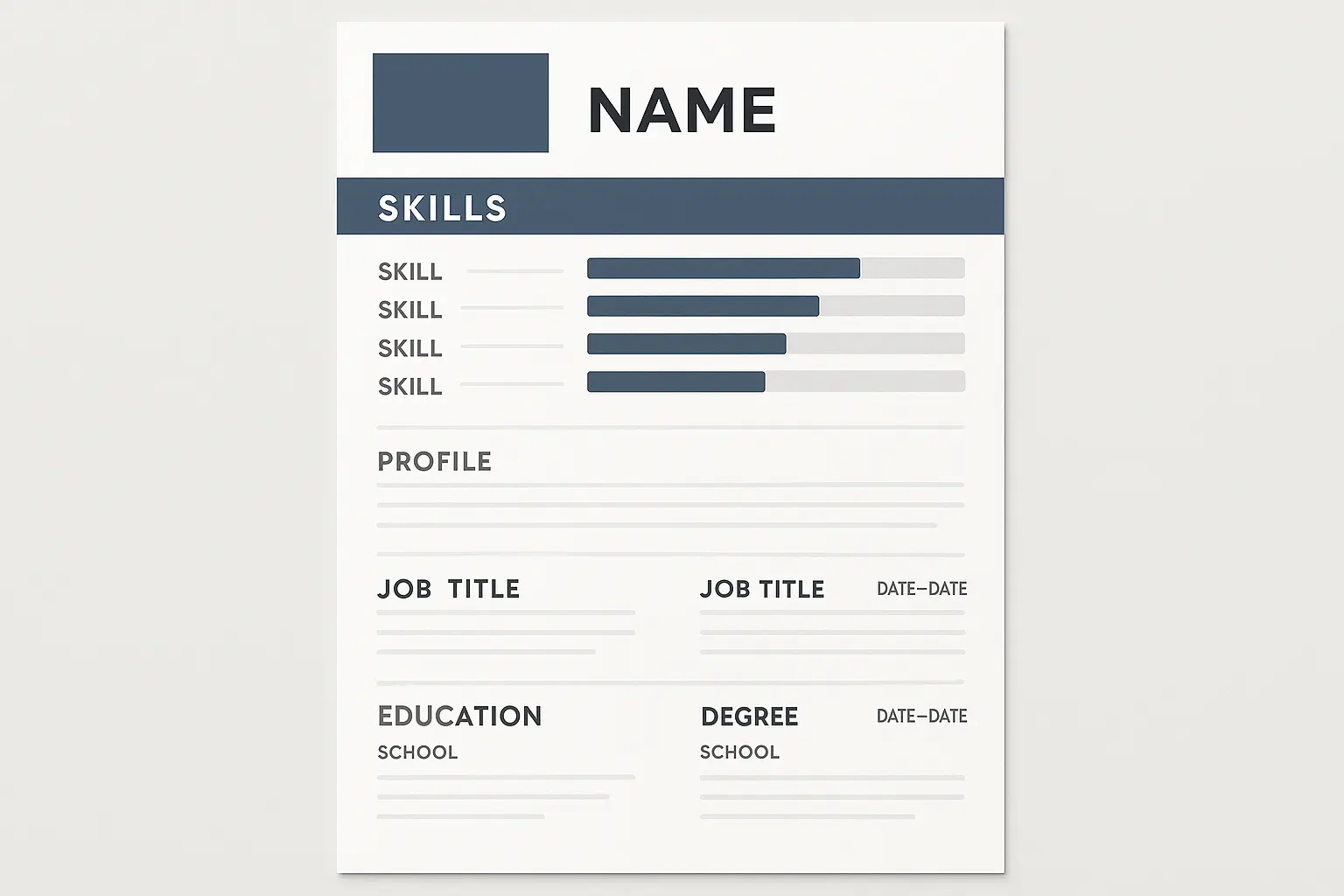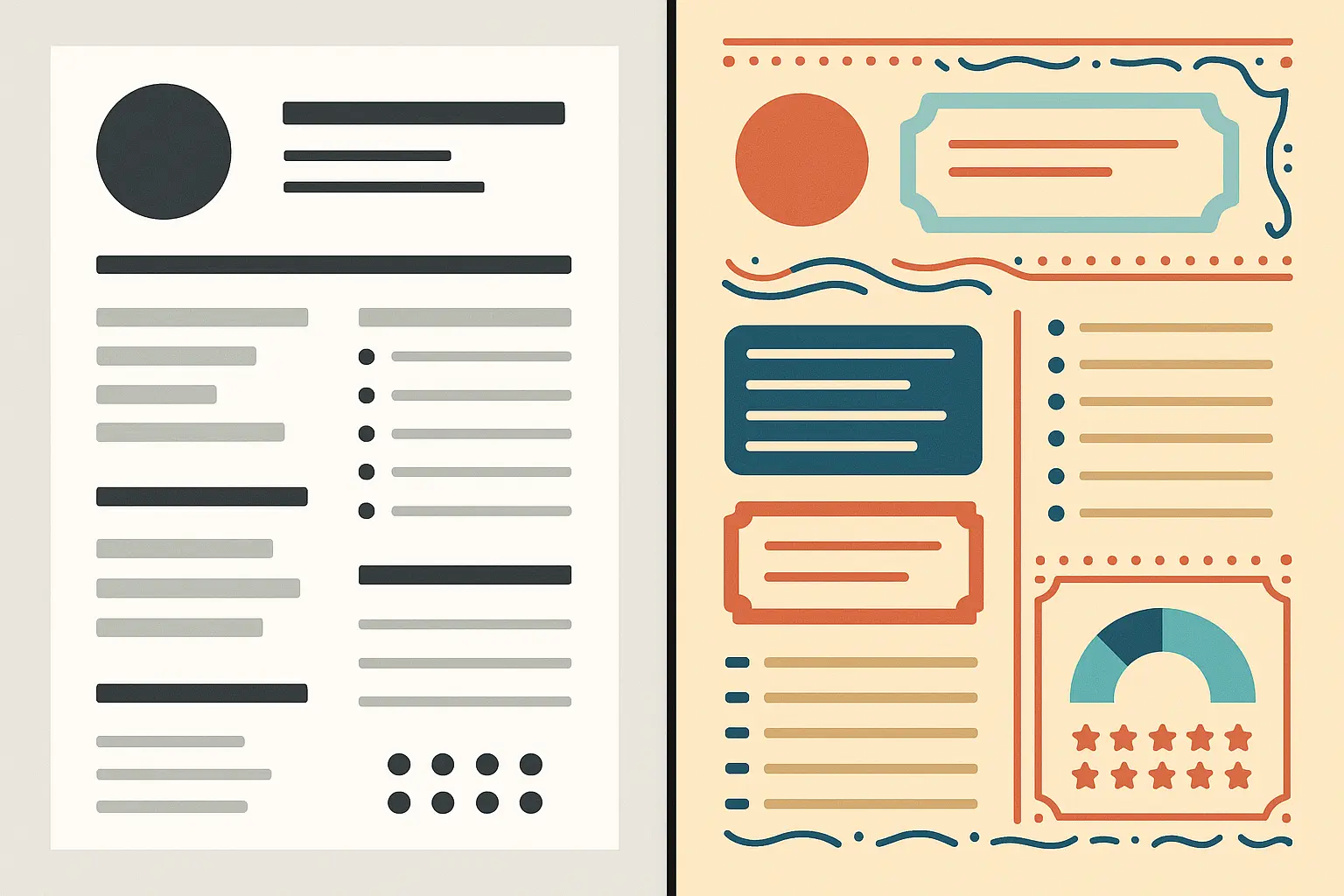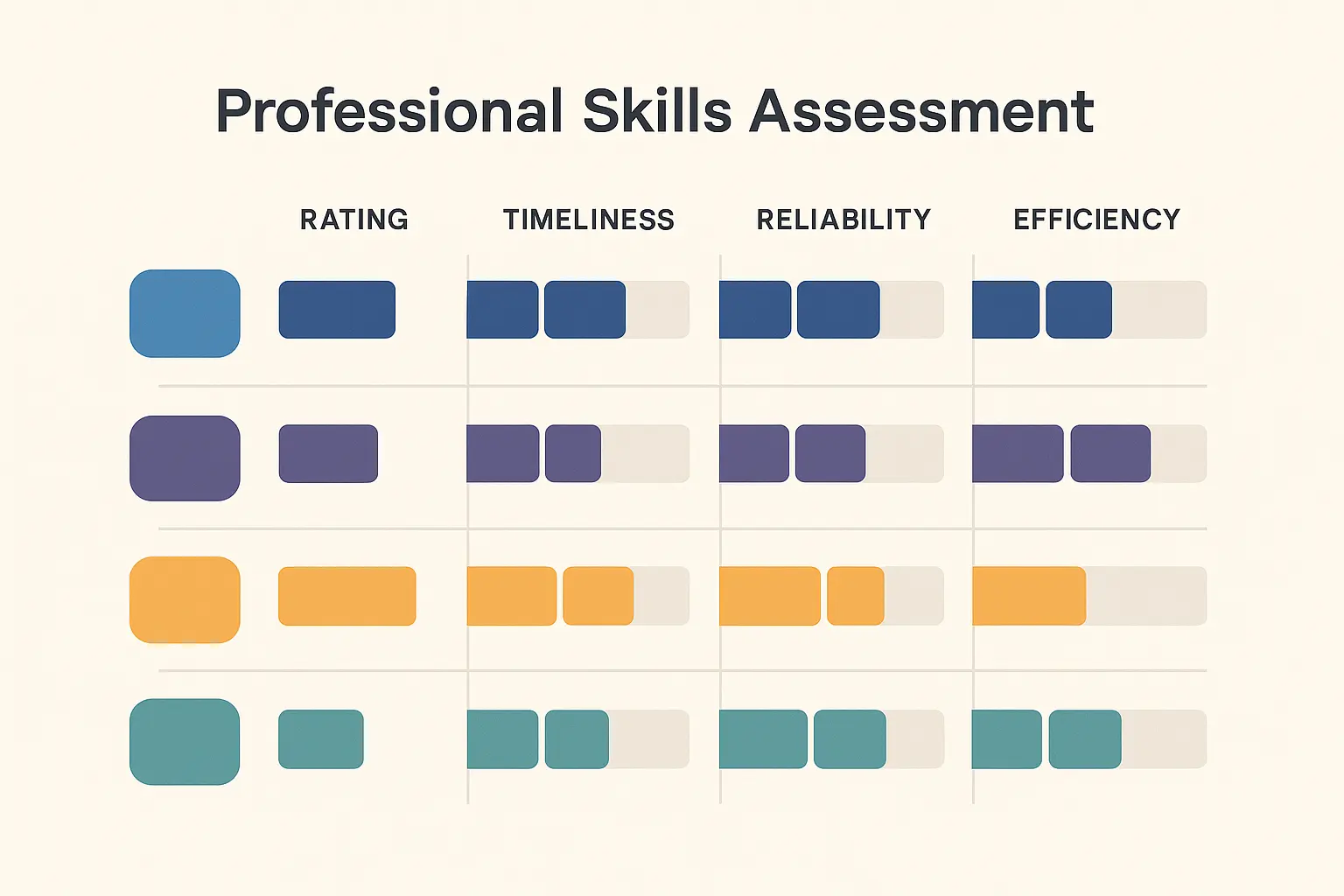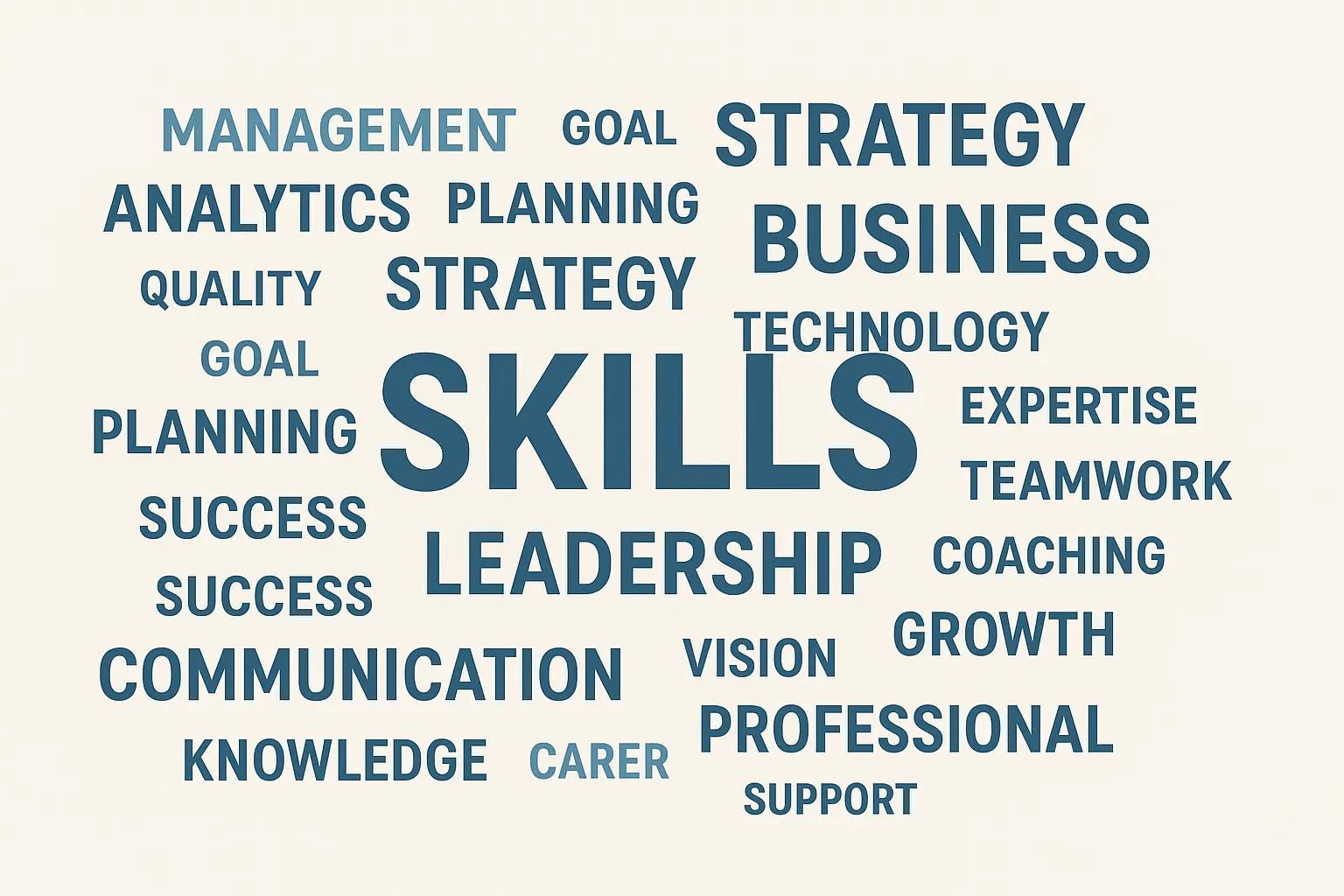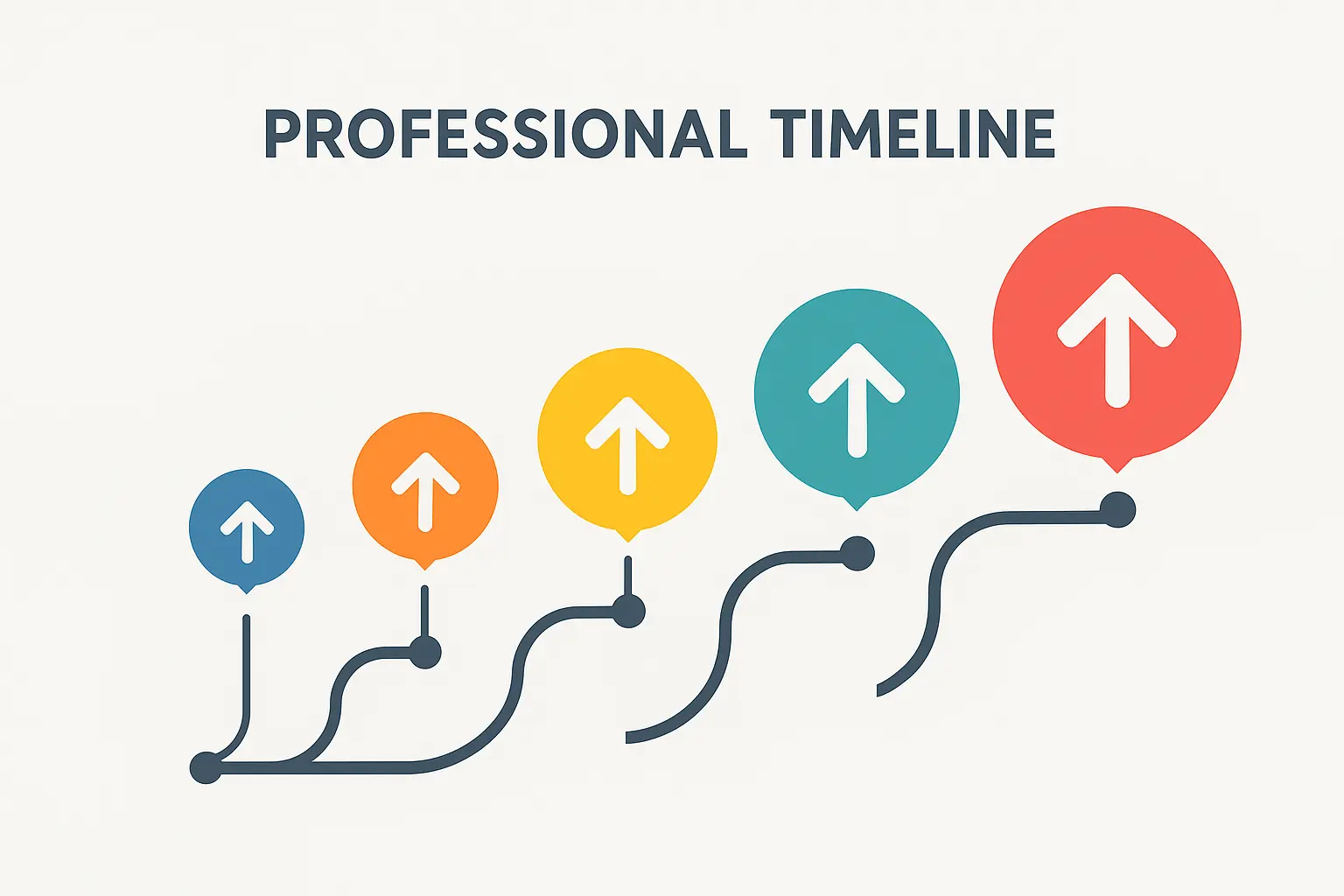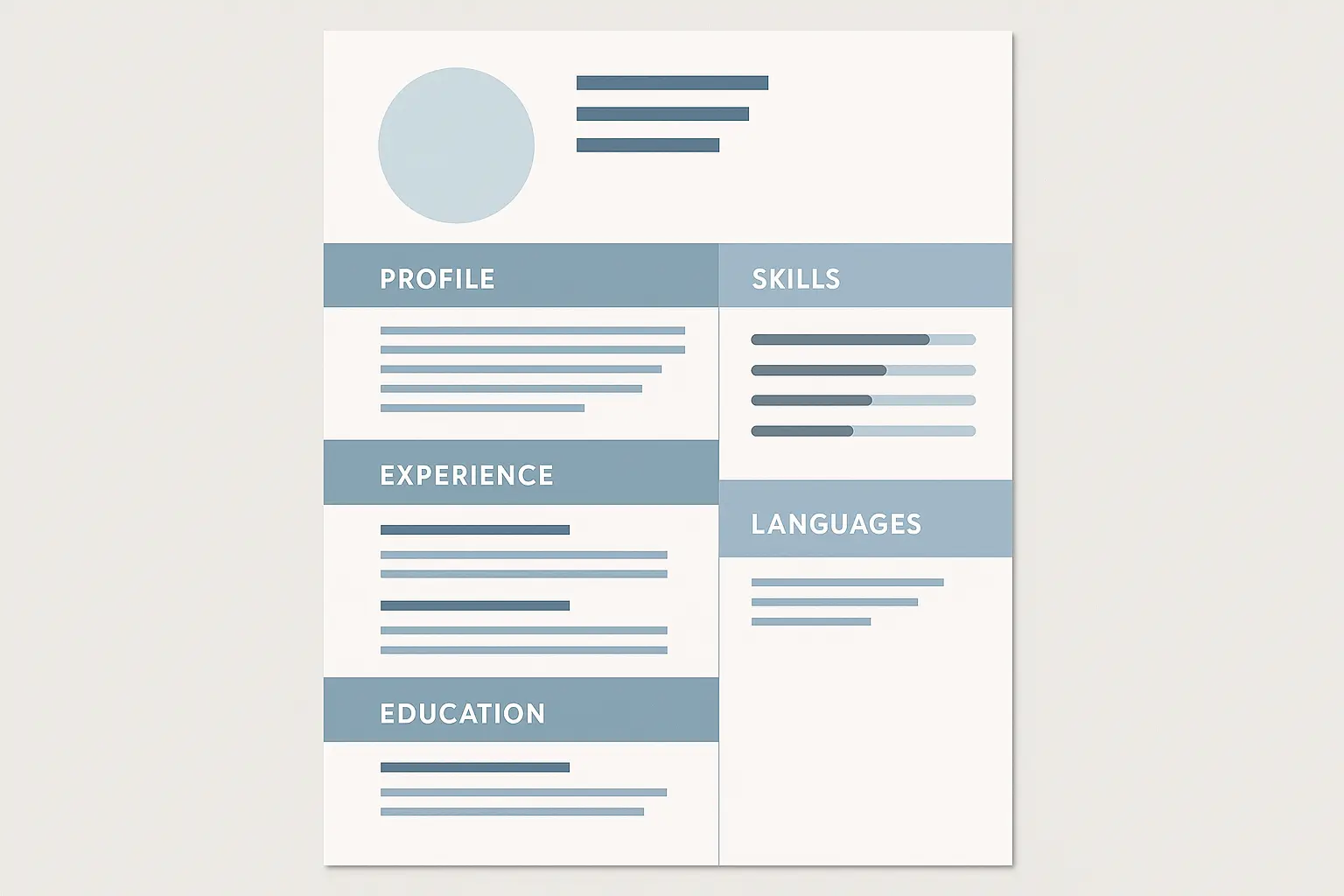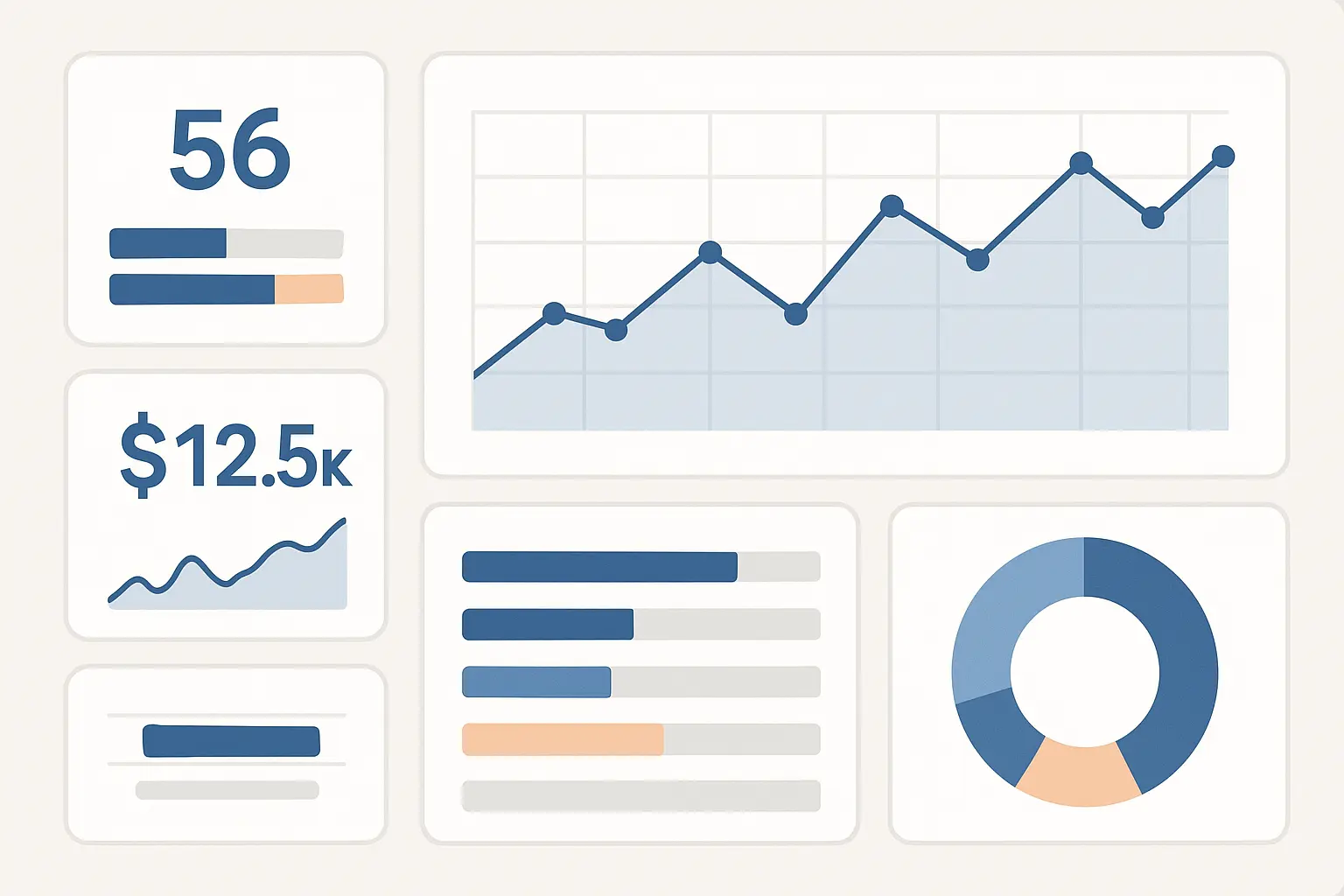Combination Resume Template Secrets That Actually Get You Hired
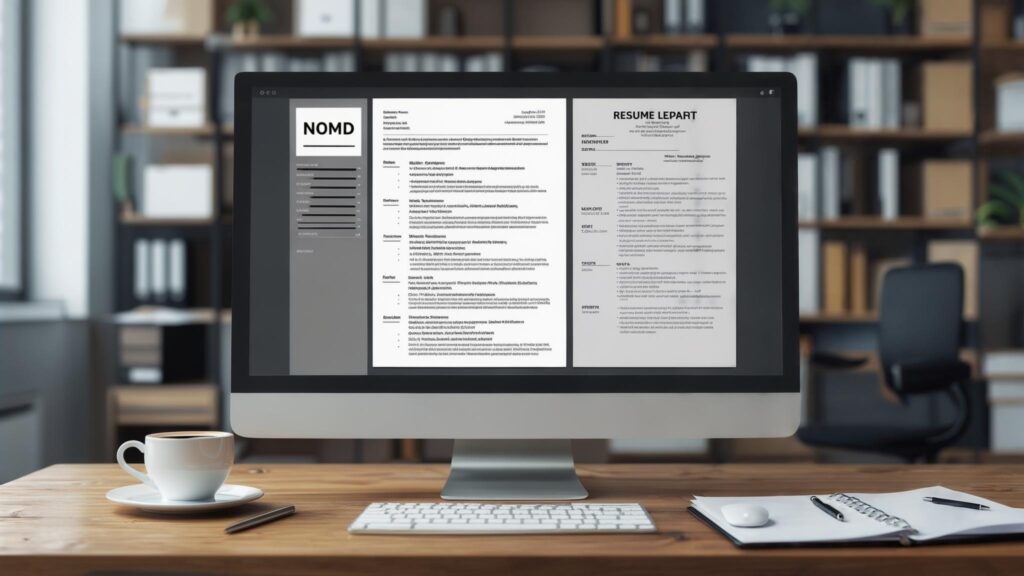
Ever feel like your resume is getting lost in a black hole? You’re not alone. With over half of companies now using AI to screen resumes, you need a format that works for both robots and humans. That’s where combination resume templates come in—they’re your secret weapon for getting noticed.
Table of Contents
-
Why Combination Resume Templates Actually Work
-
How to Pick Templates That Don’t Suck
-
Writing Skills That Employers Care About
-
Making Your Work History Flow
-
Getting the Format Right
-
Tracking What Actually Works
TL;DR
-
Combination resume templates put your skills first, then show your work history—perfect if you’re changing careers or have gaps
-
Skip free templates that break in applicant tracking systems; invest in ones that actually work
-
Lead with measurable achievements and industry keywords, not generic skill lists
-
Your work history should back up your skills claims with real examples
-
Keep formatting clean and consistent—fancy designs often backfire
-
Track which versions get responses and adjust accordingly
Why Combination Resume Templates Actually Work
Here’s the thing: most people struggle with showcasing their skills while proving they have real experience. Combination resume templates solve this by putting your best stuff up front, then backing it up with your career history.
I’ve watched too many talented people get overlooked because their chronological resume buried their best qualifications under job titles that didn’t match what employers were looking for. The right combination resume template fixes that problem.
Research shows that 94% of hiring professionals say that ATS has positively influenced their hiring goals, while 80% of job seekers say that their online job search is stressful. There’s your disconnect right there. Combination resume templates bridge that gap by satisfying both the machines and the humans reviewing your application.
Skills First Changes Everything
When you put your skills right after your contact info, you control the conversation. Instead of hoping someone will dig through your job descriptions to find relevant experience, you serve it up immediately.
Think about it: hiring managers spend maybe 10 seconds scanning your resume initially. Do you want them looking at your skills or trying to decode whether your job title at “Synergistic Solutions Inc.” is relevant?
The dual structure works because recruiters can quickly check if you have what they need, then verify you’ve actually used those skills somewhere. It’s like having your cake and eating it too.
This approach eliminates the common problem of having relevant experience buried in job descriptions that don’t immediately signal your value. The combination resume template removes that guesswork entirely by front-loading your most valuable qualifications where they’ll be seen first.
When Combination Resume Templates Make Perfect Sense
Look, combination resume templates aren’t magic bullets for everyone. But if you’re in one of these situations, they’re incredibly powerful:
|
Your Situation |
Why It Works |
What You Get |
|---|---|---|
|
Changing careers |
Skills matter more than job titles |
Shows you can do the work |
|
Have employment gaps |
Focuses on abilities, not timeline |
Reduces awkward questions |
|
Switching industries |
Highlights transferable skills |
Bridges the gap |
|
Recent graduate |
Balances education with limited experience |
Maximizes what you have |
|
Freelancer/contractor |
Shows range of project skills |
Demonstrates versatility |
Career changers: If you’re a marketing manager wanting to move into project management, lead with skills like “Cross-functional team coordination” and “Budget management ($500K+ campaigns)” before listing your marketing roles. Suddenly, you look like a project manager who happened to work in marketing.
Employment gaps: Instead of drawing attention to time off, you highlight what you can do. Include volunteer work, freelance projects, or courses that kept your skills sharp. I’ve seen people turn career breaks into strengths this way.
The combination resume template works best when you need to bridge gaps between your experience and your target role. The effectiveness becomes even more apparent when compared to traditional chronological resumes that focus primarily on work history, as the hybrid approach allows for more strategic positioning of your strongest qualifications.
Perfect Timing for Maximum Impact
Modern applicant tracking systems scan resumes in a specific order, and combination resume templates ensure your keywords and core competencies appear early in that scanning process. By front-loading your skills section with industry-specific terms and measurable achievements, you increase your chances of passing automated filters before human eyes ever see your resume.
This works particularly well when combined with ATS-friendly formatting techniques that ensure your resume passes automated screening while maintaining professional appearance for human reviewers.
How to Pick Combination Resume Templates That Don’t Suck
The template market is a minefield. Pretty designs that look great on Pinterest often fail miserably when actual employers try to read them. Here’s how to avoid the traps.
What Actually Matters in Combination Resume Templates
Forget the fancy graphics and creative layouts. You need combination resume templates that work in the real world—meaning they pass through ATS systems without breaking and look professional to human eyes.
Good combination resume templates have clean layouts, standard fonts, logical flow, and enough white space so people can actually read them. That’s it. Simple beats flashy every time.
Quality combination resume templates prioritize functionality over flashy design elements that can interfere with ATS parsing. The best options feature clean layouts that work together to create professional presentations that perform well in both automated and human review processes.
ATS Compatibility Checklist:
-
Standard fonts (Arial, Calibri, Times New Roman)
-
No weird graphics or images
-
Simple bullet points (just black dots)
-
Clear section headers
-
Consistent formatting
-
No tables or complex layouts
-
Works as both .docx and .pdf
Free vs. Premium Combination Resume Templates
Free combination resume templates are tempting, but they often come with hidden costs. Limited customization, outdated formatting, poor ATS compatibility, and designs that scream “I downloaded this from a free site.”
Premium combination resume templates cost more upfront but usually offer better customization, proven ATS compatibility, mobile-friendly designs, and ongoing updates. Plus, you’re not competing with thousands of other people using the exact same free template.
I’ve seen great candidates get overlooked because their free template made them look generic or unprofessional. Sometimes it’s worth investing in tools that actually work.
Free combination resume templates frequently lack the customization flexibility needed to create a truly personalized resume that stands out from other candidates using the same design. They may also have limited ATS compatibility testing, outdated formatting standards, or design elements that don’t translate well across different devices and platforms.
Premium combination resume templates justify their cost through features that directly impact your job search success: extensive customization options, proven ATS compatibility, mobile-responsive designs, and ongoing updates that keep your resume current with changing industry standards.
Writing Skills That Employers Care About
Most people completely botch their skills section. They either list random abilities without context or stuff it with buzzwords that mean nothing. Here’s how to do it right.
Organize Skills That Make Sense
Random skill lists are useless. Group related abilities into categories that align with what employers actually need. This helps hiring managers quickly find what they’re looking for while showing you understand what matters in your field.
Instead of: “Microsoft Office, Communication, Leadership, Excel, Teamwork, PowerPoint”
Try this:
Technical Skills: Advanced Excel (pivot tables, macros), Salesforce CRM, SQL queries
Leadership: Team management (15+ direct reports), Cross-functional coordination, Budget oversight ($2M+)
See the difference? The second version tells a story and provides context.
Effective skills organization groups related competencies into logical categories that align with your target role requirements. This approach helps hiring managers quickly identify relevant qualifications while demonstrating your understanding of what matters most in your field.
The strategic organization of skills becomes even more powerful when combined with hard skills that provide concrete evidence of your technical capabilities alongside complementary soft skills that demonstrate your professional approach.
Add Numbers Without Sounding Ridiculous
Quantify your skills whenever possible, but don’t make up numbers or exaggerate. Instead of just “project management,” write “managed cross-functional teams of 8-12 members on projects worth $500K-2M.”
This gives reviewers actual context for evaluating your experience level. Numbers cut through the noise and help your resume stand out.
|
Weak |
Strong |
Why It Works |
|---|---|---|
|
“Social media management” |
“Increased engagement 150% through strategic content” |
Shows results, not just tasks |
|
“Customer service” |
“Resolved 98% of issues on first contact, boosting satisfaction 23%” |
Proves effectiveness |
|
“Team collaboration” |
“Led 8-person cross-functional team, delivered $1.2M project early” |
Demonstrates leadership impact |
Adding measurable elements to your skills presentation provides concrete evidence of your capabilities without making unsubstantiated claims. Numbers speak louder than vague descriptions, and they help your resume stand out in a sea of generic skill lists.
According to hiring managers will spend less than ten seconds reading your resume, making strategic skills organization absolutely critical for capturing attention in that brief window.
Integration Strategy That Creates Cohesive Narratives
Your skills section shouldn’t exist in isolation from your work history—these elements need to reinforce each other throughout your combination resume template. Strategic integration involves weaving your key competencies through specific examples and achievements in your employment section.
Frame your work experience around accomplishments that directly support the skills highlighted in your opening section. If you’ve emphasized data analysis capabilities, your job descriptions should include specific examples of analytical projects, tools used, and measurable outcomes achieved.
Effective keyword integration requires natural incorporation of industry-specific terms throughout both your skills section and work history. Rather than stuffing keywords awkwardly into descriptions, use them in context when describing actual projects, tools, methodologies, or achievements.
Making Your Work History Flow
Your work history in combination resume templates serves a different purpose than in chronological formats. It’s not just listing where you worked—it’s proving you can actually do what your skills section claims.
Connect Experience to Your Skills
Every job description should reinforce the skills you highlighted up top. This isn’t always obvious, especially if you’re changing careers, but strategic framing can show how seemingly unrelated experience actually supports your target role.
Transform boring job duties into achievement statements that demonstrate valuable skills:
Instead of: “Responsible for customer service”
Write: “Resolved 95% of customer issues on first contact, improving satisfaction scores by 23%”
This shows problem-solving, communication, and analytical skills that transfer across industries.
Work history in combination resume templates needs to provide credibility and context for your skills claims while addressing potential concerns about career progression or employment gaps. Every job description should reinforce the skills you’ve highlighted at the top of your resume.
The key is identifying transferable achievements and presenting them in relevant context. This becomes particularly important for professionals who need to effectively showcase career advancement and growth within their work history section to support their skills claims.
|
Weak Description |
Strong Achievement |
Skills Demonstrated |
|---|---|---|
|
“Managed social media” |
“Increased social media engagement 150% through strategic content planning” |
Analytics, Strategy, Results-driven |
|
“Handled customer complaints” |
“Resolved 98% of escalated issues within 24 hours, reducing churn by 15%” |
Problem-solving, Communication, Customer focus |
|
“Worked on team projects” |
“Led cross-functional team of 8 to deliver $1.2M project 2 weeks ahead of schedule” |
Leadership, Project management, Collaboration |
|
“Updated databases” |
“Streamlined data entry processes, reducing errors by 40% and saving 10 hours weekly” |
Process improvement, Attention to detail, Efficiency |
Handle Gaps Without Drama
Employment gaps don’t need long explanations that draw attention to potential problems. Focus on skills you maintained or developed during breaks—volunteer work, freelance projects, continuing education, personal projects.
Brief, matter-of-fact mentions work better than defensive explanations. I’ve watched hiring managers completely ignore gaps when the surrounding content shows continued professional development.
Example: “Career Break (2022-2023): Completed advanced certification in data analysis while managing family responsibilities”
Employment gaps don’t need lengthy explanations that draw unnecessary attention to potential problems. Instead, focus on skills maintained or developed during breaks, including volunteer work, freelance projects, continuing education, or personal projects that kept you professionally current.
Create a Story That Makes Sense
Your work history should tell a logical story about your professional growth, even if your actual path wasn’t perfectly straight. Use brief connecting statements to help reviewers understand how each role built toward your current goals.
A software developer might write: “Transitioned from junior developer roles to senior positions by consistently taking on complex projects and mentoring junior team members.”
Your work history should tell a logical story about your professional development, even if your actual career path wasn’t perfectly linear. Use brief connecting statements or strategic emphasis to help reviewers understand how each role contributed to your current qualifications and career goals.
Not all work experience deserves equal treatment in your combination resume template. Prioritize roles and achievements that most directly support your target position, giving them more detailed descriptions and prominent placement.
Getting the Format Right
Perfect formatting isn’t about making your resume look pretty—it’s about making it work properly in both ATS systems and human review processes. Small details can make or break your chances.
Consistency That Actually Matters
Use the same fonts, spacing, bullet styles, and date formats throughout your entire combination resume template. Inconsistencies signal carelessness and can undermine your credibility before anyone even reads your qualifications.
Formatting Checklist:
-
Name in 18-22pt font, bold
-
Section headers in 14-16pt font
-
Body text in 10-12pt font
-
Consistent bullet points throughout
-
Uniform date formatting (MM/YYYY)
-
Proper margins (0.5-1 inch all sides)
Formatting consistency goes beyond just using the same font throughout your resume—it involves maintaining uniform spacing, bullet point styles, date formats, and alignment across all sections. These details might seem minor, but inconsistencies signal carelessness and can undermine your professional credibility.
Maintaining consistency becomes easier when you understand optimal resume length requirements that help you balance comprehensive information with clean, professional presentation across all sections.
Keep It the Right Length
Combination resume templates can easily get too long if you’re not careful. The skills-first approach actually lets you be more concise in your work history since you’ve already highlighted key competencies up front.
Focus on your most relevant achievements and use bullet points effectively. Every line should earn its place on your resume.
Combination resume templates allow more flexibility in how you present your career timeline, but this freedom requires strategic thinking about what to emphasize and what to minimize. The goal is creating a professional narrative that supports your target role while addressing any potential concerns about your background.
Make It Work on Mobile
Many hiring managers review resumes on their phones, so your combination resume template needs to look good on small screens. Test how your resume displays on different devices before sending it out.
Templates that look perfect on desktop might be completely unreadable on smartphones, potentially eliminating you from consideration.
Many hiring managers and recruiters review resumes on mobile devices, so your combination resume template needs to display properly across different screen sizes. This consideration affects font choices, spacing decisions, and overall layout design.
Technical Details That Make or Break ATS Performance
Applicant tracking systems have specific technical requirements that can cause even well-written resumes to be rejected before human review. Understanding these requirements and implementing them correctly ensures your combination resume template performs well in automated screening processes.
Submit your resume in formats that ATS systems can reliably parse, typically .docx or .pdf depending on the application system requirements. Avoid complex formatting, embedded images, or unusual fonts that might not display correctly across different platforms.
Tracking What Actually Works
Resume optimization is an ongoing process that requires data-driven decision making rather than guesswork about what employers want. Tracking your application response rates, analyzing which combination resume templates perform best, and making strategic adjustments based on actual results helps you continuously improve your effectiveness.
This systematic approach turns job searching into a measurable process with clear success metrics.
Monitor Your Response Rates
Keep a simple spreadsheet tracking where you applied, when you applied, and whether you got responses. This reveals patterns about what works in different industries or company types.
I’ve seen people discover their combination resume template works great for tech companies but falls flat with traditional industries. That’s valuable intelligence you can use to customize your approach.
Monitoring which applications generate responses helps you identify patterns about what works in different industries, company sizes, or role types. This data reveals whether your combination resume template is effective for your target market and provides insights for strategic adjustments.
Recent trends in IT leadership hiring show that companies are always looking for candidates who can help them solve transformational problems, particularly when it comes to transitioning to new technological paradigms according to Dice career experts, highlighting the importance of tracking which transformation-related keywords generate the best responses.
Test Different Versions
Create slight variations of your combination resume template to test different approaches with similar job applications. Try different skills presentations, summary statements, or formatting choices to see which versions generate better responses.
Small changes can yield surprisingly large improvements in response rates. Maybe emphasizing certain keywords works better, or perhaps a different skills organization resonates more with your target market.
Create slight variations of your combination resume template to test different approaches with similar job applications. Try different skills presentations, summary statements, or formatting choices to see which versions generate better response rates.
This testing approach provides concrete data about what works rather than relying on assumptions about employer preferences. Small changes can yield surprisingly large improvements in response rates.
Make Data-Driven Improvements
Use your tracking data to make informed decisions about resume improvements. If certain skills or achievements consistently appear in your most successful applications, make them more prominent.
Stop following generic advice and start following your own data. I’ve seen dramatic improvements when people base their resume changes on actual performance rather than theoretical best practices.
Use your tracking data to make informed decisions about combination resume template improvements rather than making changes based on generic advice that might not apply to your situation. Real performance data reveals what actually works for your specific career goals and target market.
Analyze which skills, keywords, or achievement statements appear in your most successful applications, then emphasize these elements in future versions. If certain competencies consistently generate interest, make them more prominent in your skills section.
Track response rates alongside timing patterns, application methods, and follow-up strategies that correlate with success. This comprehensive data helps you optimize your entire job search approach, beyond just your combination resume template content.
Different industries respond differently to combination resume templates, and tracking these variations helps you optimize your approach for specific sectors. Technology companies might appreciate skills-first presentation, while traditional industries might prefer more emphasis on work history.
Resume Builder IQ addresses the complexity of combination resume template optimization through AI-powered analysis and automated improvements. While tracking performance manually can be time-consuming and prone to errors, Resume Builder IQ’s platform automatically monitors which resume elements perform best across different applications and suggests data-driven improvements. The platform’s ATS-friendly templates eliminate guesswork about formatting requirements, while built-in keyword optimization ensures your combination resume template performs well in both automated and human review processes.
Your Next Steps
Creating an effective combination resume template isn’t about following a rigid formula—it’s about strategically presenting your unique story in a format that works for both machines and humans.
The key elements: choose functional templates over flashy designs, write skills sections with quantifiable evidence, and integrate your work history to reinforce your key competencies. These work together to create a cohesive narrative that helps hiring managers quickly understand what you bring to the table.
Remember, your combination resume template should evolve based on actual results. Track your response rates, test different approaches, and adjust based on what generates interviews in your target market. This turns resume writing from guesswork into a strategic process with measurable outcomes.
Success with combination resume templates comes down to three critical elements: choosing templates that prioritize functionality over flashy design, writing skills sections that provide quantifiable evidence of your capabilities, and integrating your work history to reinforce rather than repeat your key competencies. These elements work together to create cohesive professional narratives that help hiring managers quickly understand your value proposition.
The investment in getting your combination resume template right—whether through premium templates, professional guidance, or optimization tools—pays dividends throughout your career. A well-crafted combination resume template doesn’t just help you land your next job; it establishes a format and approach you can adapt for future opportunities as your skills and experience continue to grow.
Recent developments in graduate school applications show that combination format allows you to highlight key skills while still including a chronological list of relevant roles and accomplishments according to University of Cincinnati career experts, demonstrating the growing acceptance of this hybrid approach across academic and professional settings.
Getting your combination resume template right—whether through premium templates, professional help, or optimization tools—pays off throughout your career. A well-crafted combination resume template doesn’t just land your next job; it gives you a format and approach you can adapt as your skills and experience continue to grow.
Start with one strong version, track how it performs, and refine from there. Your future self will thank you for the investment.


